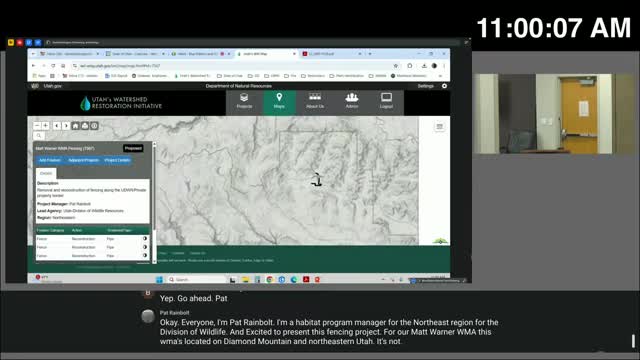Wildlife Management Area faces cattle pressure and fence deterioration
March 22, 2025 | Natural Resources Department, Utah Environment, State Agencies, Organizations, Utah Executive Branch, Utah
This article was created by AI summarizing key points discussed. AI makes mistakes, so for full details and context, please refer to the video of the full meeting. Please report any errors so we can fix them. Report an error »

The recent joint meeting of the Blue Ribbon and Habitat Council, held by the Utah Department of Natural Resources, highlighted pressing concerns regarding the management of a Wildlife Management Area (WMA) that is facing significant challenges due to surrounding private properties and livestock interference.
One of the primary issues discussed was the impact of cattle grazing on the WMA, which is known for its rich fishery and recreational opportunities, including camping and wildlife viewing. The area is a limited entry unit for deer and elk, making it a vital habitat for these species. However, the presence of cattle from nearby private lands has led to ongoing pressure on the WMA, resulting in damage to the environment and infrastructure.
The current fencing around the WMA is in disrepair, unable to effectively keep livestock out. Meeting participants noted that the fencing has deteriorated over the years, with many sections collapsing under the weight of heavy snowpacks. This not only allows cattle to enter the WMA but also poses risks to deer and elk, which can become entangled in the sagging wires. The erosion caused by cattle hooves further exacerbates the problem, contributing to nutrient runoff that fuels harmful algae blooms in the reservoir.
The discussions underscored the need for immediate action to repair and upgrade the fencing to protect the WMA's natural resources and maintain its status as a premier habitat for wildlife. The council emphasized that the WMA is intended to provide forage for deer and elk, and the ongoing grazing by livestock undermines this purpose.
As the meeting concluded, participants expressed a commitment to addressing these challenges, recognizing the importance of preserving the WMA for future generations. The outcomes of this meeting will play a crucial role in shaping the management strategies for the area, ensuring that it continues to serve both wildlife and the community.
One of the primary issues discussed was the impact of cattle grazing on the WMA, which is known for its rich fishery and recreational opportunities, including camping and wildlife viewing. The area is a limited entry unit for deer and elk, making it a vital habitat for these species. However, the presence of cattle from nearby private lands has led to ongoing pressure on the WMA, resulting in damage to the environment and infrastructure.
The current fencing around the WMA is in disrepair, unable to effectively keep livestock out. Meeting participants noted that the fencing has deteriorated over the years, with many sections collapsing under the weight of heavy snowpacks. This not only allows cattle to enter the WMA but also poses risks to deer and elk, which can become entangled in the sagging wires. The erosion caused by cattle hooves further exacerbates the problem, contributing to nutrient runoff that fuels harmful algae blooms in the reservoir.
The discussions underscored the need for immediate action to repair and upgrade the fencing to protect the WMA's natural resources and maintain its status as a premier habitat for wildlife. The council emphasized that the WMA is intended to provide forage for deer and elk, and the ongoing grazing by livestock undermines this purpose.
As the meeting concluded, participants expressed a commitment to addressing these challenges, recognizing the importance of preserving the WMA for future generations. The outcomes of this meeting will play a crucial role in shaping the management strategies for the area, ensuring that it continues to serve both wildlife and the community.
View full meeting
This article is based on a recent meeting—watch the full video and explore the complete transcript for deeper insights into the discussion.
View full meeting

